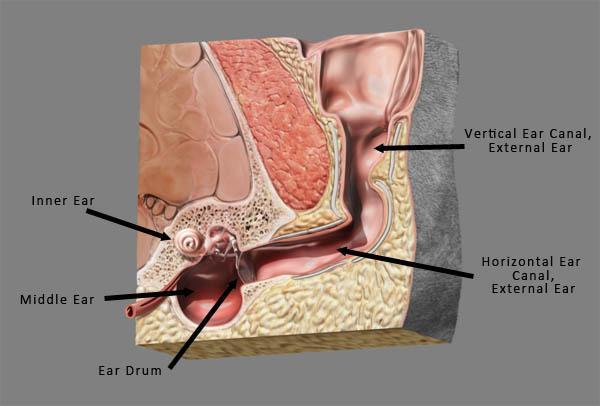by Kelly Stalpes, DVM
Ever notice your dog or cat scratching or rubbing at their ears? Or shaking their head? Red, itchy ears are a common reason for our small animal companions to visit the vet, and the medical name for this condition is otitis. Otitis externa is inflammation of the external ear canal, while otitis media is inflammation of the middle ear.
Certain factors can predispose or directly cause animals to develop otitis including allergies, trauma (foreign bodies), disorders that cause changes in skin cell turnover rate, tumors, parasites (ear mites), and internal and external ear conformation. The internal conformation of dog ears makes them susceptible since they have an L-shaped ear canal that is prone to swelling shut with inflammation and trapping exudates.
BMjX_sywpbuYcozsMAG4xrekrQNCoUz_UT4VpS6ZufVFKGIkLLyGKSiNp7x2HRrvfpcLPpZoVE2vGVDmaP1WZIbnuBKYE0WWDGz-_KMsNUXYm23KSwzH-qsbMDbWOCfpCoRxN62g
(Dog ear canal diagram from Diagnostic Imaging Atlas)
Inflammation is not only irritating and painful, but it also makes the ear more susceptible to infection with bacteria or yeast. Infection further contributes to the itching and pain, which manifests as redness of the ear, scratching, head shaking, odor, and hair loss on and around the ear.
Treatment for otitis consists of treating the underlying cause of inflammation and the infection. Both issues need to be resolved in order for the ears to return to a normal, healthy state, which is why it is important for your veterinarian to obtain a good history of the problem, do a thorough exam of the external and internal ear with an otoscope, and get a smear of the exudate in the ear to look at a sample under the microscope (cytology). The history can help determine if allergies are an underlying cause. Until the allergies are controlled, otitis and ear infections will recur. The otoscope allows for better visualization of the ear canal and the potential presence of any foreign bodies, polyps, or masses. It is also a way to visualize the ear drum to determine if it is intact or ruptured. The smear (cytology) allows evaluation for bacteria, yeast, and parasites. All are very itchy and it is important to determine if one or more is present so appropriate treatment can be initiated. Sometimes imaging (such as x-rays) may also be necessary to further evaluate disease of the middle ear.
Specific treatments are case and patient dependent, but often consist of anti-inflammatory medication, cleaning the ears, and specific treatment to clear the infection. A recheck examination, including cytology, is important to monitor the efficacy of the treatment, and if the treatment protocol should be continued, changed, or discontinued.
If you notice your pet is head shaking, scratching the ears, or has increased redness or odor in the ear, please contact your veterinarian. Otitis is uncomfortable and and the itching and self-trauma can perpetuate the problem if it is not addressed and treated. Please call the clinic at 970-963-2371 if you have any concerns about otitis in your pet.

